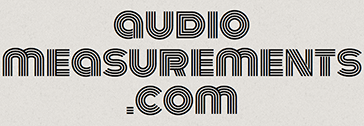RF measurement, coordination & optimization
I’ve been dealing with RF mics (Vega) since 1990 when I started working at Casa Manana theater. For most of my career I’ve been fairly RF illiterate but not suffered any serious consequences. In early 2016, I had a terrible experience mixing a show where we used some wireless mics and I trusted the tour manager to take care of the RF setup. One of the mics was taking hits for all of act 1. At intermission I vowed that I would buy an RF scanner, get the software needed to scan and coordinate frequencies and I would never let that sort of thing happen again with giving it my best effort. Fast forward to today and I own a handheld portable scanner as well as a rack mount unit. I also own a Lectrosonics Venue 2 system that can scan internally and coordinate it’s own frequencies (more later). I have multiple software applications I use in tandem with RF scanners to measure an RF environment and calculate what frequencies will work and which ones won’t.
RF Scanners:
Here is the handheld scanner I use:
rfexplorer.com
If you get one of these there are many different options. The least expensive, simplest for our purposes is the WSUB1G model. I’d recommend upgrading the antenna and adding a SMA to BNC adapter (more details later)
Here is the rack mount scanner I use:
RF Venue – RF Explorer Rack Pro
The RF Venue Rack Pro is the same radio as the handheld version. Different form factor. I actually bought the Rack Pro first and quickly realized that for quick and dirty RF work, the handheld version was more useful.
There are a few nice things about the Rack Pro that warrant your consideration.
1. It has a BNC antenna connection
2. It comes with a better antenna for the frequency range we’re typically interested in for RF mics & IEMs.
3. It will mount in a rack (so it’s safe) and you could permanently attach it to your RF antenna distribution system so you’re measuring RF with the exact antenna system you’ll be using.
With that said, once you have a handheld scanner with the upgraded Rack Pro antenna and the required SMA to BNC adapter, you’ve got the same options without the ability to rack mount the scanner.
One downside to the handheld RF Explorer is that it is fragile and due to the USB port being on the bottom (where you would logically sit it down to scan), you have to pay attention to how you place it, etc…
I can argue that both are necessary in different situations.
RF Scanning software:
For PC there are a number of options. I’ll explain later which ones I recommend and why. In the meantime, some of them are either free or very inexpensive.
rfexplorer.com – touchstone
I purchased the handheld scanner and began learning how to use it with Touchstone (free).
Then I purchased Touchstone Pro for $50.
Then I purchased the RF Venue – RF Explorer Rack Pro which at the time was bundled with Clear Waves.
rfexplorer.com – Clearwaves
Picture Touchstone, Touchstone Pro & Clearwaves as the same program with different levels of features. Touchstone looks and behaves exactly like Touchstone Pro except you can’t export your data. In order to take your scan data and export it into a RF coordination app (list to follow), you at least need Touchstone Pro. Even better is ClearWaves which is the equivalent of Touchstone Pro with internal RF coordination functionality. Clearwaves is currently the only RF scan / coordination app I’m aware of.
If you’re a mac user, you’ll want to go straight to RF Venue’s VANTAGE app (OSX 10.10 or higher)
RF Venue – Vantage RF scanning software
I have been told that eventually Vantage will incorporate RF coordination but for the moment the data gathered with Vantage will need to be exported into an RF coordination app like Professional Wireless Services – IAS (PC only)
professionalwireless.com – IAS (intermodulation analysis system)
IAS (PC only) comes in 2 versions.
The basic version is $250.
The professional version is $550.
professionalwireless.com – IAS basic professional version feature comparison
To be clear, IAS is king of RF coordination. It’s used by the biggest players in the RF coordination industry and for good reason. I currently down own IAS because I want a version that runs on a Mac. IAS doesn’t currently provide any scanning function so you have to use it in tandem with something like Vantage, Touchstone Pro or Clearwaves. Considering that Clearwaves can do both RF scanning and coordination, why would someone want to export their scan data and import it into IAS? IAS is the most evolved RF coordination software package available. It has the biggest and most current list of existing RF systems built into it so if you’re trying to coordinate a large venue or multiple venues, IAS is ready to work for you.
If you have a simple RF environment and only one brand of RF gear, depending on which gear you have, you may be able to get by without a scanner or coordination software. I’ll explain.
Lectrosonics, Sennheiser, Shure, etc… all have systems that can scan internally and with their free software, coordinate their own RF. This may be all you need.
lectrosonics.com – Wireless Designer
sennheiser.com – Wireless System Manager
shure.com – Wireless Workbench
(add any more that exist)
